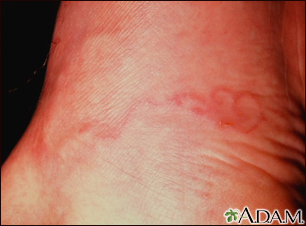Creeping eruption
Definition
Creeping eruption is a human infection with dog or cat hookworm larvae (immature worms).
Alternative Names
Parasite infection - hookworm; Cutaneous larvae migrans; Zoonotic hookworm; Ancylostoma caninum; Ancylostoma braziliensis; Bunostomum phlebotomum; Uncinaria stenocephala
Causes
Hookworm eggs are found in the stool of infected dogs and cats. When the eggs hatch, the larvae can infest soil and vegetation.
When you come into contact with this infested soil, the larvae can burrow into your skin. They cause an intense inflammatory response that leads to a rash and severe itching.
Creeping eruption is more common in countries with warm climates. In the United States, the Southeast has the highest rates of infection. The main risk factor for this disease is contact with damp, sandy soil that has been contaminated with infected cat or dog stool. More children than adults become infected.
Symptoms
Symptoms of creeping eruption include:
- Blisters
- Itching, may be more severe at night
- Raised, snakelike tracks in the skin that may spread over time, usually about 1 cm (less than one half inch) per day, usually on the feet and legs (severe infections may cause several tracks)
Exams and Tests
Your health care provider can often diagnose this condition by looking at your skin. In rare cases, a skin biopsy is done to rule out other conditions. In very rare cases, a blood test is done to see if you have increased eosinophils (a type of white blood cell).
Treatment
Anti-parasitic medicines may be used to treat the infection.
Outlook (Prognosis)
Creeping eruption often goes away by itself over weeks to months. Treatment with anti-parasitic medicines helps the infection go away more quickly.
Possible Complications
Creeping eruption may lead to these complications:
- Bacterial skin infections caused by scratching
- Spread of the infection through the bloodstream to the lungs or small intestine (rare)
When to Contact a Medical Professional
Make an appointment with your provider if you or your child have skin sores that are:
- Snake-like
- Itchy
- Moving from one area to another
Prevention
Public sanitation and deworming of dogs and cats have decreased hookworm infestation in the United States.
Hookworm larvae often enter the body through bare feet, so wearing shoes in areas where hookworm infestations are known to occur helps prevent infection.
Gallery




References
Dinulos JGH. Infestations and bites. In: Dinulos JGH, ed. Habif's Clinical Dermatology. 7th ed. Philadelphia, PA: Elsevier; 2021:chap 15.
Nash TE. Visceral larva migrans and other uncommon helminth infections. In: Bennett JE, Dolin R, Blaser MJ, eds. Mandell, Douglas, and Bennett's Principles and Practice of Infectious Diseases. 9th ed. Philadelphia, PA: Elsevier; 2020:chap 290.